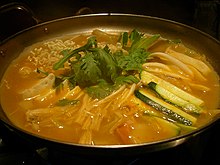Budae-jjigae: Difference between revisions
No edit summary |
No edit summary |
||
| Line 28: | Line 28: | ||
*[[Jjigae]] |
*[[Jjigae]] |
||
*[[Korean cuisine]] |
*[[Korean cuisine]] |
||
==References== |
|||
<references/> |
|||
==References== |
==References== |
||
Revision as of 07:39, 17 July 2008
| Budae-jjigae | |
 Budae jjigae | |
| Korean name | |
|---|---|
| Hangul | 부대찌개 |
| Hanja | |
| Revised Romanization | budae jjigae |
| McCune–Reischauer | pudae tchigae |
Budae jjigae (IPA: [putɛ ʨigɛ]), lit. "army base stew") is a jjigae, a thick Korean soup similar to a Western stew. Soon after the Korean War, meat was scarce in Seoul, Korea. Some people made use of surplus foods from U.S. Army bases around the Uijeongbu area such as hot dogs and canned ham (such as Spam) and incorporated it into a traditional spicy soup flavored with gochujang (red chili paste).
Budae jjigae is still popular in South Korea, and the dish often incorporates more modern ingredients such as instant ramen noodles and even sliced American cheese. Other ingredients may include ground beef, beans, minari (dropwort), green onions, tteok, tofu, chili peppers, kimchi, garlic, mushrooms, and onions.
Origin
The dish originated after the Korean War, and for a time afterwards, people had little to eat. Most people had to fill their stomachs with the food distributed on the street called Kkulkkuli juk (meaning "pig's gruel"). People made this dish by combining leftover Spam and hot dogs from U.S. Army restaurants and whatever else was available. All the leftovers were combined with water in a large pot and boiled.[1] - The dish is also referred to as Johnson Tang (존슨탕), combining the surname of Lyndon B. Johnson and tang (탕, 湯) a word meaning soup.[2] The city of Uijeongbu, which is north of Seoul and has many army bases, is famous for its budae jjigae. In the late 20th century, the city of Uijeongbu has stipulated that the dish be referred to as Uijeongbu jjigae, though not many restaurants follow this guideline.
Recipe
- Start with a base of gochujang (Korean red pepper paste) mixed with minced garlic and onion. You can also use a jarred red paste. jjigae.[3] The spicy flavor can differ from quantity of red sauces.
- Add water, but not too much. Turn the heat to high. Stir it continuously.
- Then, put into the pot altogether with chopped onion, garlic. Include some sliced leeks if you have some. It can help your taste more impressive on your try.
- At this point, prepare for meats. The tradition is hot dogs and spam. But it never limits those of ingredients.
- It is the very time you should add the vegetables. If you put into vegetables first, they are easily softened and lose shape. Tofu is necessary item.
- Bring in some noodles. This is almost ending recipe. Ramen noodles (Korean: Ramyeon 라면) are popular, as are clear Korean noodles. If the water is already gone considerably, add more not to be too salty.
See also
References
References
